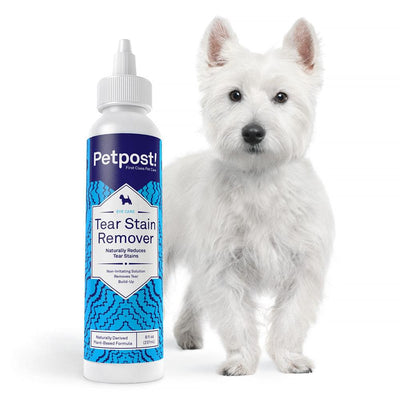How to Get Rid of Tear Stains

You love snuggling up to that adorable face, but lately it looks like Bitsy is crying all the time. You know she's not actually sad, but the fur under her eyes has turned reddish brown, maybe even black. If you're not sure how to get rid of tear stains, it's actually a simple process. With a little bit of routine care, you can get Bitsy's coat back to that powder-white fluff you've always loved.
Know What Causes the Tear Stains
The tears themselves are not causing the stains. For a variety of possible reasons, when Bitsy's eyes get irritated the tears aren't dissipating the way they do in most dogs. It could be because Bitsy produces more tears than most dogs or that her eyes tend to get irritated more easily. It might even have something to do with the areas of the eye that typically drain the tears being clogged in some way.
No matter what is causing the tears to stay on her coat, the tears themselves aren't causing the stains. It's the dirt and debris that the tears collect. That's why it's often a reddish brown color. In most cases, you're not going to be able to treat the cause of the tears themselves, so knowing how to get rid of tear stains comes down to treating the area where the tears settle.
The Treatment Process
The good news is that the treatment itself is a great time for you to spend pampering your best friend. You only need a few supplies such as 4-5 cotton balls, a safe cleaning solution. After that, it's a very simple process:
- Shake the bottle of Tear Stain Remover.
- Squeeze the solution onto a cotton ball.
- Rub the stained area to get rid of dirt and gunk.
Most tear stain removers are safe for external use, but you want to be careful not to get any of the product in Bitsy's eyes or mouth. When you first start, you'll want to repeat this process for 5-7 consecutive days in order to clean the area. After that, weekly treatments will typically protect the fur from future stains. As the new fur grows in, you'll start to see the roots coming in as snow white as the rest of her coat.
Eventually the stains will go away because you're getting rid of the dirt that causes them. If you'd like to get rid of the faster, use cotton balls to apply a mixture of 10% hydrogen peroxide with water to the area. You'll be safely coloring Bitsy's hair, although we recommend patience and letting the fur grow back naturally.
Pick the Right Treatment
Not all tear stain removers are created equally. Some contain antibiotics which have not been approved for use on dogs. In addition, antibiotics for tear stains are unnecessary. If you notice a discharge that suggests an infection or if Bitsy is scratching at the area, you need to see your veterinarian. While microbes can grow in the area of the tear stains, infections caused by the tears themselves are unlikely.
Since you'll be treating the tear stains regularly, it's critical that you choose a product that is safe for your pet. Go for a natural formula.
Figuring out how to get rid of tear stains on your pet comes down to understanding your treatment options. In a small number of cases, allergies cause the excess tearing, but for most pets the cause is something genetic that is going to have to be treated regularly. Once you know how to get rid of tear stains though, the best part will be that you have an excuse to spend a little mommy or daddy time with Bitsy curled up in your lap. Not that you needed an excuse in the first place.









Leave a comment